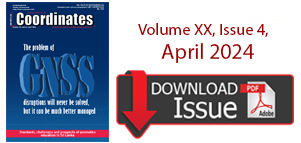Articles in the Articles Category

The bottom line is that the LightSquared signals interfere with GPS, and LightSquared should not be allowed to proceed until the interference problems are resolved. To understand this perspective, some background is useful. The spectrum allocated to GPS for its L1 signal is from 1559 MHz to 1591 MHZ. This spectrum is shared by other Global Navigation Satellite Systems such as the EU’s Galileo, China’s Compass, and shortly also by Russia’s GLONASS, which uses the 1598 MHz to 1605 MHz band for its present signals. Basically, GNSS signals occupy the 1559 MHz – 1605 MHz band.

Precision viticulture (PV) is styled from the zonal management paradigm of precision agriculture, where large homogeneous fields are divided into smaller units based on yield or other field characteristics which may be differentially managed (Lamb et al., 2002, Bramley, 2009, Bramley and Robert, 2003) (Note that McBratney et al. (2005) suggest the definition of precision agriculture is continually evolving as we develop further technologies and greater awareness of agricultural processes). PV acknowledges the numerous spatial variations that affect grape quality and yield, including soil characteristics, pests and diseases and topography (Hall et al., 2003, Arnó et al., 2009), providing land managers with the tools to quantify and manage this variability (Proffitt, 2006). Land managers can thus ‘selectively’ treat areas, for example by the variable application of mulch, water, fertiliser, sprays etc.

The most important achievement of the National Spatial Data Infrastructure (NSDI) has been bringing together many agencies to work for a cause. It had not been easy and it took more than ten years to reach at this stage. In addition, we were involved in the standards development activities of NSDI for Metadata (2005/2009) and National Spatial Data Exchange Standards (NSDE- 2003). NSDI is seen as Standards organization and Bureau of Indian Standards (BIS) is in the process of constituting a mirror committee for ISO TC 211 with NSDI as anchor.

GIS is becoming pervasive and is finding applications across a wide range of applications across the globe. It is becoming an effective language for communication. GIS companies like Esri are leveraging the advancements in information and communication technology and implementing GIS in multiple patterns like desk top, client server, federated, Web/Cloud and Mobile.
Over 650 years of experience in spatial information management, land administration and spatial enablement were percolated into 22 presentations offering a raft of initiatives and insights across the world corresponding with the theme of the forum, “Beyond Spatial Enablement’- Land Administration to support Spatially Enabled Government”
December 2011:
NSDI 2011, 21 – 23 December, Banglore, India,
www.nsdiindia.gov.in

Recent geodetic and oceanographic MSL studies have shown that neither the sea levels nor the land are permanent with respect to time variations. The data analysis of tide gauges produces ‘relative’ sea level changes. However, using tide gauge data alone, it is impossible to distinguish between any true sea level variation and any changes in ground level at a tide gauge site. GPS monitoring can be used to decouple vertical land movements from change in relative MSL, so that tide gauge can provide estimates of changes in absolute MSL. In order to monitor “absolute” changes in sea level, the rates of any vertical land movements at a tide gauge must be determined and subtracted from the resulting rate of tide records [e.g. IPCC, 2001 and Bingley et al, 2000]. Consequently, a sea level monitoring system has been installed at Alexandria tide gauge site containing a GPS receiver as a geodetic monitoring technique to perform this task.

The concepts proffered in paper generally are in relation to developed jurisdictions that have fully embraced the Information Age and its significant investments in digital data management. Since 2001, and as a means of improving the administration of marine and coastal spaces through decision support, interested members of the international geomatics community have increased research efforts towards the development of marine cadastres in various jurisdictions. Among them are researchers from Canada, Australia and the United States of America (USA) (Collier, Leahy and Williamson, 2001; Ng’ang’a, Sutherland and Nichols, 2002; Sutherland, Wilkins, and Nichols, 2002; Barry, Elema and van der Molen, 2003; Binns et al., 2003; Ng’ang’a et al., 2004; Sutherland, 2004; Sutherland and Nichols, 2004; FGDC, 2008). The main focus of this paper is Canada but developments from the U.S. and Australia are briefly discussed.









 (5.00 out of 5)
(5.00 out of 5)